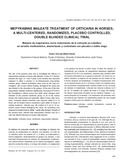| dc.rights.license | http://creativecommons.org/licenses/by-nc-sa/3.0/ve/ | |
| dc.contributor.author | Ural, Kerem | |
| dc.contributor.author | Ulutas, Bülent | |
| dc.date.accessioned | 2010-11-08T16:39:06Z | |
| dc.date.available | 2010-11-08T16:39:06Z | |
| dc.date.issued | 2010-10-31 | |
| dc.identifier.issn | 0798-2259 | |
| dc.identifier.uri | http://www.saber.ula.ve/handle/123456789/31782 | |
| dc.description.abstract | El objetivo del presente estudio fue investigar la eficacia del
maleato de mepiramina en caballos con urticaria. Un total de
31 caballos, entre las edades de 1 y 8 años, se matricularon y
fueron asignados aleatoriamente en grupos de placebo o una
inyección intramuscular de maleato de mepiramina. Evaluaciones
clínicas fueron realizadas por el mismo investigador, quien
anotó la evolución clínica, a lo largo del estudio y la asignación
a los grupos fue hecha a doble ciego. Al final del estudio, el
tratamiento con maleato de mepiramina disminuyó significativamente
(P<0,001) los resultados, mientras que cambios débiles
fueron detectados en el grupo de placebo. En todos los caballos
tratados, la mejoría de las lesiones se dio dentro de las
6 horas después del tratamiento. Completa recuperación clínica
se detectó dentro de 6 a 18 horas y todos los caballos tratados
estuvieron completamente curados dentro de las 24 horas
de iniciado el tratamiento. Urticaria fue todavía evidente en 8
de los 14 caballos de control sin tratar a lo largo del estudio.
No fueron observadas recaidas en los caballos tratados 1 semana
después de la terapia. Los resultados del presente estudio
indican que maleato de mepiramina puede ser una terapia
segura y eficaz para los caballos con urticaria. | es_VE |
| dc.language.iso | es | es_VE |
| dc.publisher | SABER-ULA | es_VE |
| dc.rights | info:eu-repo/semantics/openAccess | |
| dc.subject | Urticaria | es_VE |
| dc.subject | Caballo | es_VE |
| dc.subject | Tratamiento | es_VE |
| dc.subject | Maleato de mepiramina | es_VE |
| dc.title | Mepyramine Maleate treatment of Urticaria in horses; a multi-centered, randomized, placebo controlled, double blinded clinical trial | es_VE |
| dc.title.alternative | Maleato de mepiramine como tratamiento de la urticaria en caballos; un estudio multicéntrico, aleatorizado y controlado con placebo a doble ciego | es_VE |
| dc.type | info:eu-repo/semantics/article | |
| dc.description.abstract1 | The aim of the present study was to investigate the efficacy of
mepyramine maleate in horses with urticaria. A total of 31 horses,
between the ages of 1 and 8 years, were enrolled and randomly
assigned to either a placebo or an intramuscular mepyramine
maleate group. Clinical evaluations were done by the same investigator,
who scored clinical healing, throughout the study and
was blinded to the allocation to the groups. At the end of the trial,
mepyramine maleate treatment significantly decreased (P<0.001)
the investigator’s clinical scores and while weak changes were
detected in the placebo treatment group. In all of the horses
treated, the lesions improved gradually within 6 hours after treatment.
Complete clinical remission was detected within 6 to 18
hours and all treated horses completely cured within 24 hours of
starting treatment. Urticaria was still evident in 8 out of 14 untreated
control horses throughout the study. No recurrency was
observed in treated horses within 1 week after therapy. Results of
the present study indicate that mepyramine maleate may be a
safe and effective therapy for horses with urticaria. | es_VE |
| dc.description.colacion | 493 - 497 | es_VE |
| dc.description.email | uralkerem@gmail.com | es_VE |
| dc.description.frecuencia | Bimestral | |
| dc.identifier.depositolegal | 199102ZU46 | |
| dc.publisher.pais | Venezuela | es_VE |
| dc.subject.institucion | Universidad del Zulia (LUZ) | es_VE |
| dc.subject.institucion | Universidad de Los Andes (ULA) | es_VE |
| dc.subject.keywords | Urticaria | es_VE |
| dc.subject.keywords | Horse | es_VE |
| dc.subject.keywords | Treatment | es_VE |
| dc.subject.keywords | Mepyramine maleate | es_VE |
| dc.subject.seccion | Revista Científica: Medicina Veterinaria | es_VE |
| dc.subject.thematiccategory | Medio Ambiente | es_VE |
| dc.subject.tipo | Revistas | es_VE |
| dc.type.media | Texto | es_VE |


